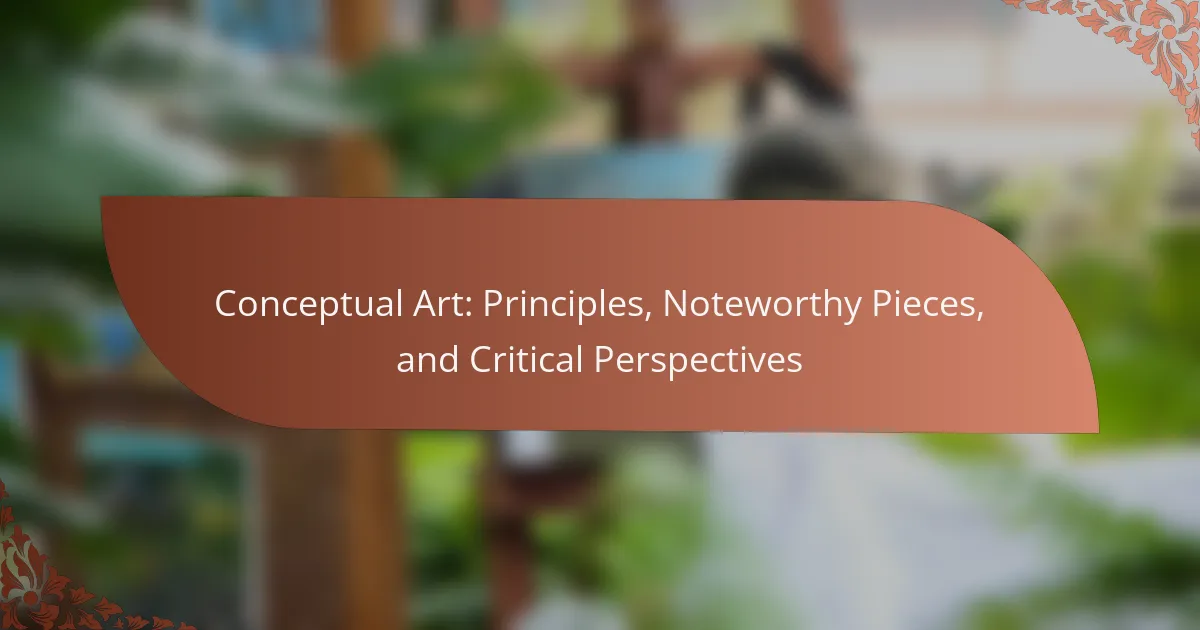Conceptual art challenges traditional aesthetics by prioritizing ideas and viewer engagement. This article explores its fundamental principles, highlights noteworthy pieces like Duchamp’s “Fountain,” and examines critical perspectives on its impact. Additionally, we will discuss various movements within conceptual art and emerging trends that incorporate digital integration and social engagement.
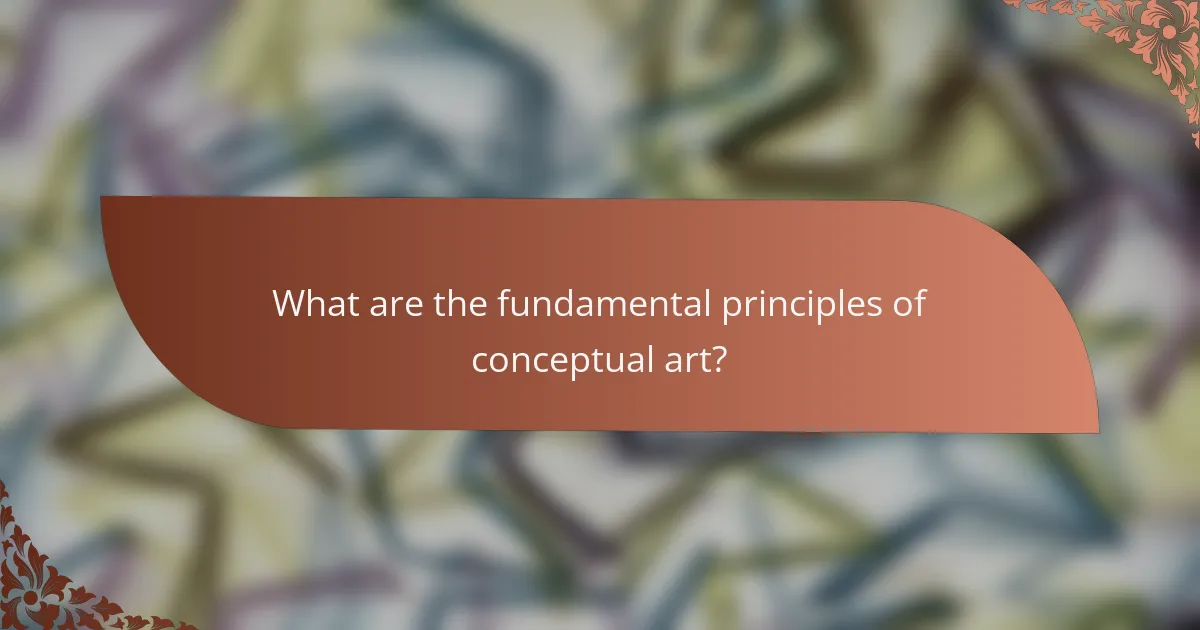
What are the fundamental principles of conceptual art?
Conceptual art emphasizes ideas over traditional aesthetic values. Its fundamental principles include the prioritization of concept over form, the use of everyday objects, and the engagement of the viewer in interpretation. This art form often challenges conventional notions of what art can be, encouraging critical thinking and dialogue. Noteworthy pieces exemplify these principles, such as Marcel Duchamp’s “Fountain” and Yoko Ono’s “Cut Piece.” These works provoke questions about authorship, context, and meaning, reflecting the unique nature of conceptual art.
How does conceptual art differ from traditional art forms?
Conceptual art prioritizes ideas over traditional aesthetics, focusing on the concept rather than the medium. Traditional art often emphasizes technical skill and visual appeal, while conceptual art challenges these norms. Noteworthy pieces, like Marcel Duchamp’s “Fountain,” illustrate this shift by presenting everyday objects as art. Critical perspectives highlight how conceptual art invites viewers to engage intellectually, altering the role of the audience in the artistic experience.
Why is the idea more important than the aesthetic in conceptual art?
The idea is more important than the aesthetic in conceptual art because it prioritizes meaning over form. Conceptual art challenges traditional notions of creativity, focusing on the artist’s intent and the message conveyed. This approach emphasizes the intellectual engagement of the viewer, fostering critical thinking and dialogue. Noteworthy pieces often illustrate this principle, where the concept drives the work’s significance rather than its visual appeal.
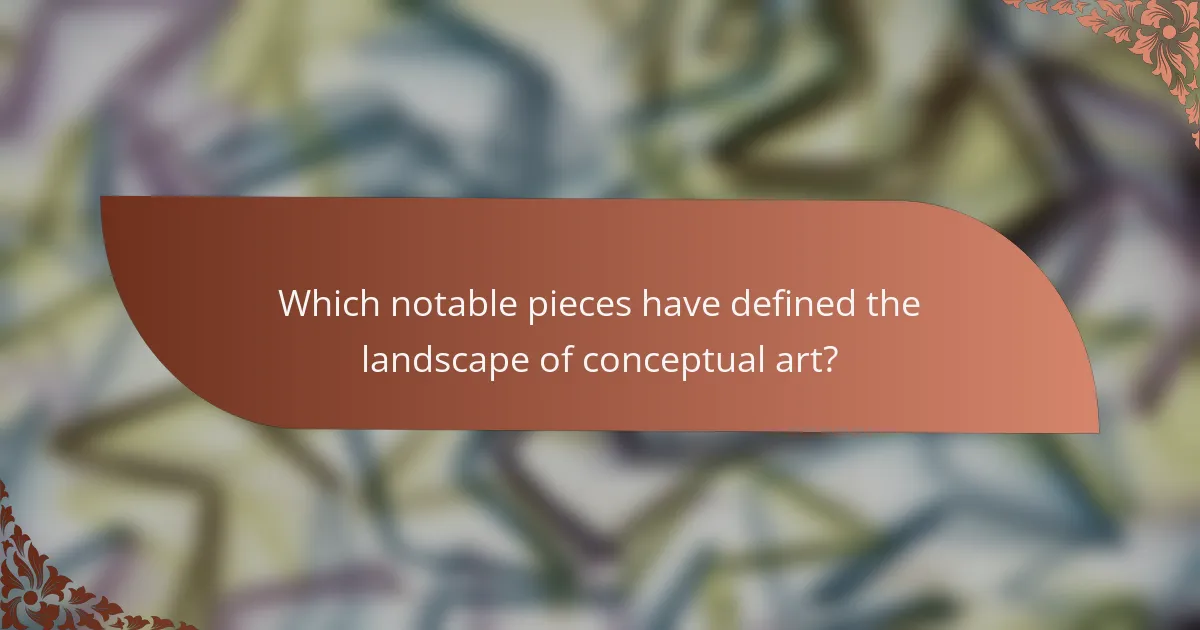
Which notable pieces have defined the landscape of conceptual art?
Notable pieces that have defined conceptual art include Marcel Duchamp’s “Fountain,” Sol LeWitt’s wall drawings, and Yoko Ono’s “Cut Piece.” These works emphasize ideas over traditional aesthetics. Duchamp’s piece challenged notions of art, while LeWitt’s drawings focused on the concept of execution. Ono’s performance engaged the audience in a unique way, highlighting interaction as a key element of conceptual art.
How did Marcel Duchamp’s “Fountain” influence contemporary art?
Marcel Duchamp’s “Fountain” revolutionized contemporary art by challenging traditional notions of what constitutes art. It introduced the concept of readymades, emphasizing ideas over craftsmanship. This shift influenced artists to prioritize conceptual approaches, leading to movements like Minimalism and Postmodernism. Duchamp’s work questioned the role of the artist and the definition of artistic value, paving the way for diverse interpretations and expressions in contemporary art. As a result, “Fountain” remains a pivotal reference point in understanding the evolution of artistic practices today.
What is the significance of Joseph Kosuth’s “One and Three Chairs”?
Joseph Kosuth’s “One and Three Chairs” is significant as it challenges traditional notions of representation in art. The piece consists of a physical chair, a photograph of that chair, and a dictionary definition of “chair.” This arrangement illustrates the relationship between language, perception, and reality. It exemplifies the core principle of conceptual art, emphasizing ideas over aesthetic value. By presenting multiple interpretations of a single entity, Kosuth invites viewers to question the nature of meaning in art.
How do contemporary artists like Damien Hirst contribute to conceptual art?
Contemporary artists like Damien Hirst significantly contribute to conceptual art by challenging traditional notions of art and emphasizing ideas over aesthetics. Hirst’s works, such as “The Physical Impossibility of Death in the Mind of Someone Living,” provoke discussions about life, death, and the value of art. His innovative use of materials, like preserved animals, exemplifies a unique attribute of conceptual art, where the concept often outweighs the physical form. This approach encourages audiences to engage with the philosophical implications of art, reshaping critical perspectives in the contemporary art scene.
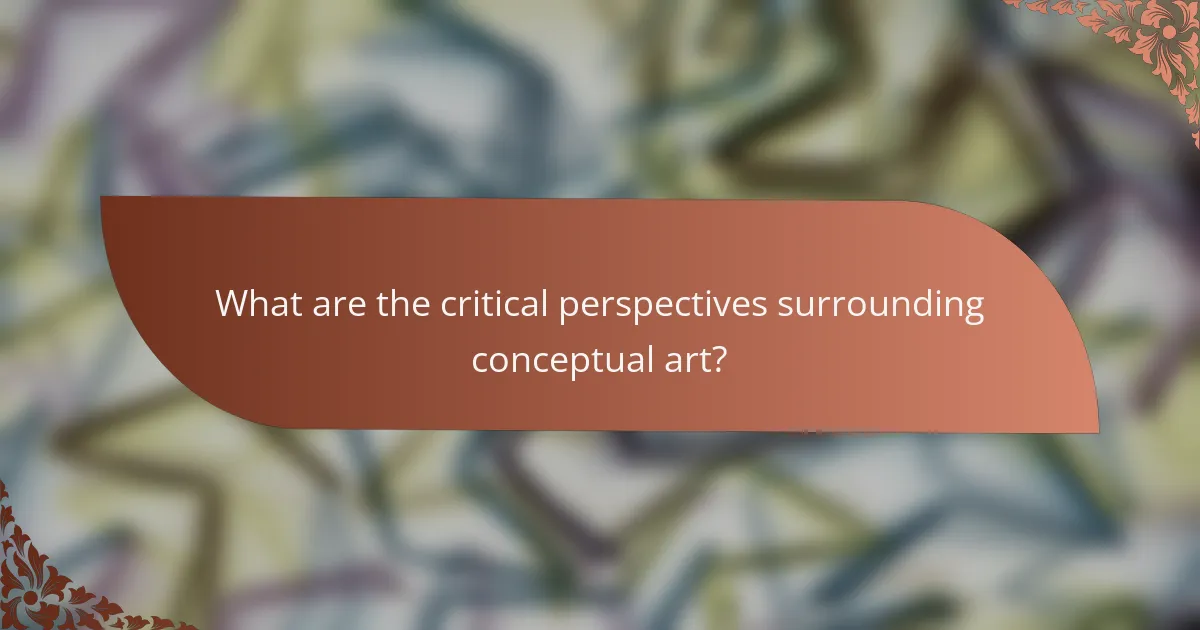
What are the critical perspectives surrounding conceptual art?
Critical perspectives on conceptual art emphasize its challenge to traditional aesthetics and its focus on ideas over visual representation. Critics argue that conceptual art can alienate audiences due to its abstract nature. Some view it as a revolutionary movement, while others see it as elitist. Noteworthy discussions include the role of the artist as a facilitator of ideas and the impact of context on interpretation. Additionally, debates arise around the commodification of art and the value placed on the concept versus the execution.
Why do some critics argue that conceptual art lacks craftsmanship?
Critics argue that conceptual art lacks craftsmanship because it prioritizes ideas over technical skill. This perspective suggests that the focus on concepts can diminish the value of traditional artistic techniques. Many believe that true artistry is rooted in the mastery of materials and methods, which conceptual art often overlooks. This debate highlights the tension between innovation and established practices in the art world.
How do cultural contexts shape the interpretation of conceptual art?
Cultural contexts significantly influence how conceptual art is interpreted. Different cultures bring unique perspectives, values, and historical backgrounds that shape the understanding of artistic intent and meaning.
For instance, Western audiences may emphasize individualism and personal expression, while Eastern perspectives might focus on community and collective experiences. This divergence can lead to varied interpretations of the same artwork, highlighting the role of cultural identity in the appreciation of art.
Additionally, cultural symbols and references within conceptual art can resonate differently across societies. An artwork that utilizes local traditions may be celebrated in one culture yet overlooked in another.
Overall, the interpretation of conceptual art is a dynamic interplay between the artwork and the cultural contexts of its viewers.
What role does the viewer play in the experience of conceptual art?
The viewer plays a crucial role in the experience of conceptual art by actively interpreting and engaging with the artwork. Unlike traditional art, where meaning may be more overt, conceptual art relies on the viewer’s perception and thought processes to derive significance. This interaction transforms the viewer into a participant, shaping the artwork’s meaning through personal insights and emotional responses.
The impact of the viewer is also evident in how different audiences can interpret the same piece uniquely, showcasing the diverse perspectives that conceptual art invites. This variability highlights the unique attribute of conceptual art: its reliance on subjective experience rather than a fixed narrative. As a result, the viewer’s role becomes essential in creating a dynamic and evolving conversation around the artwork.
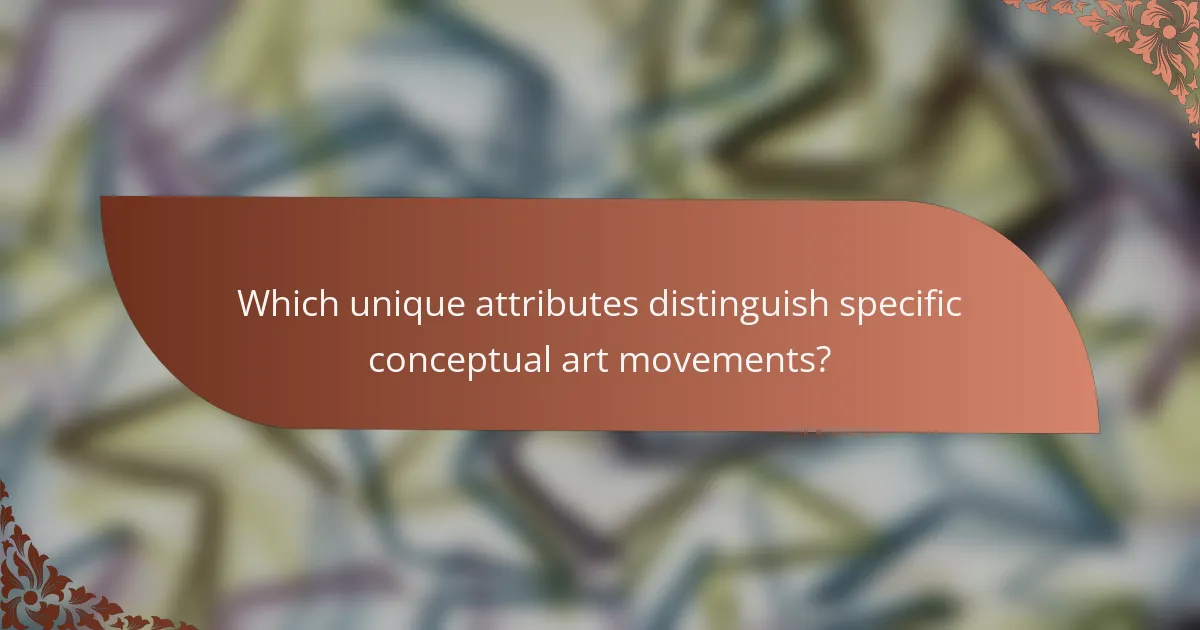
Which unique attributes distinguish specific conceptual art movements?
Conceptual art movements are distinguished by unique attributes that reflect their philosophies and approaches. For instance, Dadaism emphasizes absurdity and anti-art sentiments, while Minimalism focuses on simplicity and the reduction of form. Fluxus challenges traditional boundaries of art through interdisciplinary practices, merging art with life. Surrealism explores the unconscious mind, utilizing dream-like imagery and unexpected juxtapositions. Each movement’s unique attributes shape its impact and legacy in the art world.
How does institutional critique manifest in the works of artists like Hans Haacke?
Institutional critique in the works of artists like Hans Haacke manifests through the examination of art institutions and their socio-political contexts. Haacke’s pieces often reveal the underlying power structures and economic influences within the art world. For example, his installation “MoMA Poll” questioned the Museum of Modern Art’s role in shaping public opinion by soliciting visitors’ views on political issues. This approach highlights the intersection of art, politics, and institutional authority, fostering critical discourse around the responsibilities of cultural institutions. Haacke’s work exemplifies how conceptual art can serve as a tool for social critique, encouraging audiences to reflect on the implications of institutional practices.
What is the relationship between conceptual art and performance art?
Conceptual art and performance art are intertwined, as both challenge traditional art forms and emphasize ideas over aesthetics. Conceptual art prioritizes the concept behind the work, while performance art often embodies those concepts through live actions. Noteworthy examples include Marina Abramović’s “The Artist Is Present,” which merges both forms by using the body as a medium for conceptual exploration. This relationship highlights how performance can serve as a vehicle for conveying complex ideas, making the audience an integral part of the experience.
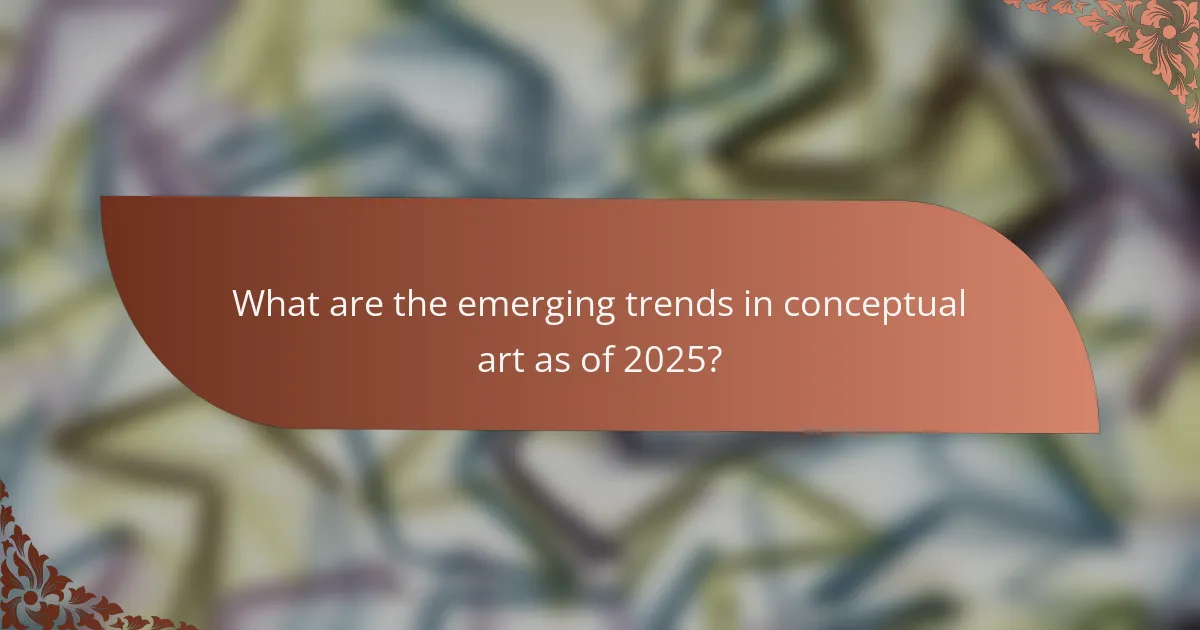
What are the emerging trends in conceptual art as of 2025?
Emerging trends in conceptual art as of 2025 emphasize digital integration, social engagement, and sustainability. Artists increasingly use technology to create immersive experiences, blending virtual and physical realms. Collaborative projects that address social issues are gaining prominence, fostering community participation. Additionally, eco-conscious practices are influencing materials and themes, reflecting a global awareness of environmental challenges.
How is technology influencing contemporary conceptual art practices?
Technology significantly influences contemporary conceptual art practices by enabling new mediums and interactive experiences. Digital tools allow artists to explore ideas through virtual reality, augmented reality, and artificial intelligence. These advancements facilitate collaboration and audience engagement, transforming traditional art forms. For instance, artists can now create immersive installations that challenge perceptions and provoke thought. Moreover, social media platforms provide a global stage for sharing and critiquing conceptual art, expanding its reach and impact. As a result, technology reshapes the dialogue around art, making it more accessible and participatory.
What role do social media platforms play in the dissemination of conceptual art?
Social media platforms significantly enhance the dissemination of conceptual art by providing accessible channels for artists to share their work. These platforms facilitate direct engagement between artists and audiences, allowing for real-time feedback and dialogue. Artists can showcase their conceptual pieces through images, videos, and live streams, reaching a global audience instantaneously.
The visual nature of platforms like Instagram and Pinterest aligns well with the aesthetic qualities of conceptual art, enabling artists to present their work in visually compelling ways. Additionally, social media fosters community-building among artists and art enthusiasts, creating networks that amplify visibility and appreciation for conceptual art.
Engagement metrics, such as likes and shares, serve as indicators of audience interest and can influence the success of conceptual art pieces. As a result, artists can adapt their approaches based on audience responses, leading to innovative practices within the conceptual art movement. Overall, social media plays a crucial role in shaping the contemporary landscape of conceptual art.
What are the best practices for engaging with conceptual art in a gallery setting?
Engaging with conceptual art in a gallery setting involves active participation and critical thinking. Observe the artwork closely, considering the ideas and intentions behind it. Reflect on the context and the artist’s message, which often challenges traditional perceptions of art. Engage with gallery staff or attend guided tours to deepen your understanding. Participate in discussions with other visitors to share interpretations and insights. Embrace the ambiguity and complexity of conceptual art, as it invites diverse perspectives and personal reactions.
